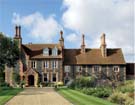Former rectories for sale
Some of the most intriguing country houses for sale were once rectories


Many of England's most intriguing country houses have church connections, be they former abbey properties acquired by the nobility after the Dissolution, or grand rectories built by landowners to guarantee their younger sons' place in society. Search for prime property for sale In the mid 1800s, the 'scattered' village of Hawkedon, nine miles south of Bury St Edmunds, Suffolk, was a parish of 339 souls and 1,461 acres, where the living was 'a rectory valued in the king's books at £7.10s and in the gift of H. J. Oakes Esq.'(Topographical Dictionary of England, 1848). In 1850, the same Henry J. Oakes, a prosperous Bury banker who lived at Thurston End Hall, built an impressive rectory for his son, the Rev Orbell Plaimpain Oakes, who lived there in some style 'with his wife, six children, servants and their relations'. Even by the standards of the day, this was a substantial house, built in the Victorian Gothic style of brick under a slate roof, and 'commanding extensive and handsome views and surrounded by neat lawns, terraces and grounds containing fish ponds'. It was rented to the diocese of Ely, which took on its repair and maintenance, before it was eventually sold into private ownership in the mid 1900s. Repair and maintenance was the first thing on the agenda for its current owner, Michael Beach, when, in 2002, he bought Hawkedon House with 55 acres of land and embarked on a three-year renovation of the fabric and interior. Now, a rejuvenated Hawkedon House, with its three grand reception rooms, study, snooker room, a state-of-the-art kitchen/breakfast room, eight bedrooms and seven bathrooms, plus a separate office building and a four-bedroom cottage (let at £18,000 a year), is for sale through Jackson-Stops & Staff (01638 662231; www.jackson-stops.co.uk/) at a guide of £3.75 million. Unlike Hawkedon, whose Victorian credentials are there for all to see, the delightful, Grade II*-listed Old Rectory at Cossington, Leicestershire, described by Pevsner as 'one of the best small domestic buildings in the county', is a fascinating jigsaw of architectural styles created over 500 years, with successive rectors adding rooms, wings, façades and features as the fancy took them. Approached from the front, the house looks medieval with its stone façade, mullioned windows and 16th-century wing half-timbered in the Cheshire style, but the 18th-century western façade is typically Georgian, fronting large, light, well-proportioned rooms. A north-east wing and rear extension were built after 1840, with the morning room added in about 1870. Recent secular owners have restored and refurbished the Old Rectory's many historic elements, from the heavily timbered 16th-century solar and closet, to the Elizabethan fireplace in the morning room, and the William Morris wallpaper in the reception hall. The 6,146sq ft of accommodation includes four main reception rooms, a kitchen/breakfast room, six bedrooms, three bathrooms, a two-bedroom stable flat, and a further coach-house flat. And, this being Leicestershire, it has extensive stabling, barns and training facilities, and is wonderfully well protected by its own 35 acres of formal gardens, paddocks, woods, moat, wildfowl lake and wildlife sanctuary. Knight Frank (01789 297735; www.knightfrank.co.uk) quote a guide price of £2.75m. Before the Dissolution, Denham Priory in Buckinghamshire was one of many country retreats owned by Westminster Abbey, where ailing monks could escape the insalubrious air of the city. Unusually, today's classic 18th-century priory, on the outskirts of picturesque Old Denham village, was built in 1789 by the then lord of the manor, Sir William Bowyer, not as a home for a dependent relative, but to house the village's deserving poor and their warden. The deal was agreed following a vestry meeting at the Swan Inn, during which Sir William was plied with copious quantities of wine. He later tried to withdraw his gift, but was told in no uncertain manner that his parishioners would take a dim of view of any such action. Some 125 years later, the Priory reverted to the owners of Denham Court, and it became the home of the rector of Denham from 1945 until 1960. The exquisite Priory, with its Dutch gabling and immaculate gardens on the banks of the River Misbourne was bought by Norman Gerard in 1989. He transformed it into an enchanting family home with four reception rooms, a study, an office, a kitchen/breakfast room, master and guest suites, three further bedrooms, two family shower rooms and a splendid vaulted games suite. An annexe provides separate studios for staff and guests. Mature manicured gardens bordering the golf club include an outdoor heated swimming pool and a tennis court. Joint agents Knight Frank (01494 675368' www.knightfrank.com) and Savills (01494 731950 www.savills.co.uk) quote a guide price of £3.5m. Search for prime property for sale
Sign up for the Country Life Newsletter
Exquisite houses, the beauty of Nature, and how to get the most from your life, straight to your inbox.
-
 'Monolithic, multi-layered and quite, quite magnificent. This was love at first bite': Tom Parker Bowles on his lifelong love affair with lasagne
'Monolithic, multi-layered and quite, quite magnificent. This was love at first bite': Tom Parker Bowles on his lifelong love affair with lasagneAn upwardly mobile spaghetti Bolognese, lasagne al forno, with oozing béchamel and layered meaty magnificence, is a bona fide comfort classic, declares Tom Parker Bowles.
By Tom Parker Bowles
-
 Country houses, cream teas and Baywatch: Country Life Quiz of the Day, April 24, 2025
Country houses, cream teas and Baywatch: Country Life Quiz of the Day, April 24, 2025Thursday's Quiz of the Day asks exactly how popular Baywatch became.
By Toby Keel